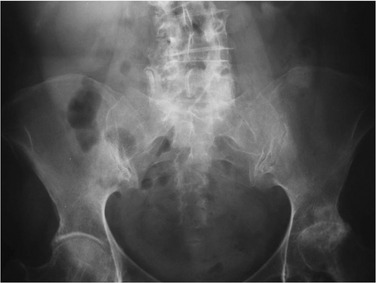CHAPTER 10 Preoperative Planning for Primary Total Hip Arthroplasty
CLINICAL EVALUATION
Clinical evaluation of the patient should comprise a careful history and physical examination to ensure that the hip is indeed the primary source of the pathologic process. A history of groin pain aggravated by activities such as attempting to put on shoes and socks or getting out of a chair all tend to point to the hip as the source of pain rather than the lower back. A concomitant spinal pathologic process often coexists and can act as a confounder. A diagnostic intra-articular injection of local anesthetic has been used as a discriminator, but strict asepsis is essential for this procedure. Additionally, we have found that the addition of a corticosteroid provides little clinical benefit and also increases the risk of infection with subsequent THA.1 Clinical examination remains the gold standard, and reproduction or exacerbation of the patient’s symptoms by stressing the affected hip in flexion and attempted internal rotation will usually confirm that the hip is the source of the patient’s symptoms. Patients should, nonetheless, be warned that in the presence of a spinal pathologic process, they may continue to experience regional hip pain even after otherwise successful THA. Additionally, a history of prior lumbar spinal surgery or sciatica should raise concerns regarding possible tethering of the sciatic nerve roots, which may increase the risk of iatrogenic stretch injury to the sciatic nerve during surgery. In this respect, it is important to ensure that patients have realistic expectations regarding the achievable outcomes of THA as per their individual clinical circumstances.
Clinical examination of the hip should include an assessment of abductor muscle strength as well as adductor tightness. On occasion, in the presence of a marked adduction contracture, adductor tenotomy to enhance stability of the total hip construct as well to facilitate subsequent rehabilitation may have to be considered. Palpation of the greater trochanteric bursa region may reveal evidence of greater trochanteric bursitis, which can also be a source of pain in the hip area not only before surgery but also postoperatively. The presence of trochanteric bursitis together with abductor weakness could be indicative of an underlying abductor tear of the insertion into the greater trochanter that may require meticulous reattachment at the time of surgical exposure.2 Abductor strength should generally not fall below grade 3 (able to abduct against gravity when side-lying). The presence of muscle weakness worse than otherwise clinically expected should alert one to the possibility of an additional concomitant pathologic process such as an abductor tear or proximal myopathy.
Clinical evaluation of leg length discrepancy should include examination of the patient’s spine to check for possible presence of a fixed scoliosis (usually degenerative) (Fig. 10-1). The patient’s perception leg length discrepancy should also be established, because the perception could be at odds with the clinical and radiographic situation. Careful preoperative counseling of the patient is essential to ensure that he or she has realistic expectations regarding what is achievable in this clinical setting.
PREOPERATIVE PREPARATION
Patients should undergo appropriate general physical assessment and workup to ensure that they are indeed medically fit to undergo THA. Given that the average age of patients undergoing THA at my center is 72 years, and that these patients have a mean of three comorbid medical conditions, preoperative internal medicine and/or anesthesia consultation is generally appropriate. Screening for preoperative anemia and discussing with the patient various blood conservation strategies (including preoperative autologous blood donation, use of erythropoietin, or intraoperative blood salvage) is an essential step to reduce allogenic transfusion rates. Recently, allogenic transfusion rates of 39% or higher have been reported, and every effort should be made to reduce this requirement.3 As yet, the role for routine perioperative administration of β-blockers to reduce cardiac risk has not been firmly established for all patients; however, the use of β-blockers for “high risk” patients is now strongly advised, with consideration being given to modify this approach in patients with a history of severe asthma or a tendency towards congestive heart failure.4 In addition to the medical preparation, attention should be paid to ensure that patients are both mentally and physically prepared for the surgery. Anxiety and depression can contribute to higher postoperative pain levels and inferior clinical outcomes after surgery.5 If deemed appropriate, preoperative counseling may be of value for both patient and surgeon. Physical preparation could include a referral to a nutritionist in an attempt to address issues such as obesity and diabetic control, if indicated. A general cardiovascular conditioning program that includes specific preoperative exercises to strengthen musculature around the hip and upper body in preparation for use of assistive devices with mobilization after surgery (together with instruction in the use of the latter) will help facilitate a shortened hospital stay.6








